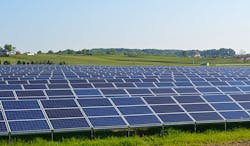Standard Solar installs 3.3-MW PV project for Isle of Wight School system
The Isle of Wight County Schools in Virginia says it's among the first in the area to transition to clean energy with the installation of a combined 3.3MW solar system, which will offset nearly 50% of the total electricity requirements of seven of its schools.
The rooftop arrays, installed by Standard Solar, are expected to generate about 4,252-MWh of clean energy each year.
Standard Solar owns and operates the systems. It provided engineering and design expertise and construction oversight for the installation on the rooftops of Windsor High School, Windsor Elementary School, Carrollton Elementary School, Carrsville Elementary School, GD Tyler Middle School and Smithfield Main.
Isle of Wight County Schools’ division Superintendent Jim Thornton said, “Incorporating solar energy is cost-effective and helps the environment while reducing energy expenses and funneling savings to resources that directly impact student success.”
Standard Solar’s Director of Business Development John Finnerty added that the project will help the environment and save money for the school system over the next 20 years.
About the Author
EnergyTech Staff
Rod Walton is head of content for EnergyTech.com. He has spent 17 years covering the energy industry as a newspaper and trade journalist.
Walton formerly was energy writer and business editor at the Tulsa World. Later, he spent six years covering the electricity power sector for Pennwell and Clarion Events. He joined Endeavor and EnergyTech in November 2021.
He can be reached at [email protected].
EnergyTech is focused on the mission critical and large-scale energy users and their sustainability and resiliency goals. These include the commercial and industrial sectors, as well as the military, universities, data centers and microgrids.
Many large-scale energy users such as Fortune 500 companies, and mission-critical users such as military bases, universities, healthcare facilities, public safety and data centers, shifting their energy priorities to reach net-zero carbon goals within the coming decades. These include plans for renewable energy power purchase agreements, but also on-site resiliency projects such as microgrids, combined heat and power, rooftop solar, energy storage, digitalization and building efficiency upgrades.
